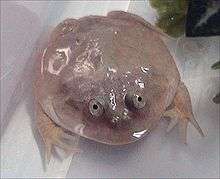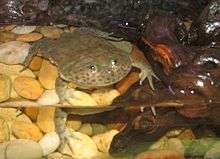Lepidobatrachus laevis
Lepidobatrachus laevis, widely known as Budgett's frog, is a species of frog in the family Ceratophryidae, discovered by John Samuel Budgett.[2] It is often kept as a pet. It has acquired a number of popular nicknames, including hippo frog,[3] Freddy Krueger frog,[3] and escuerzo de agua.[4]
| Lepidobatrachus laevis | |
|---|---|
 | |
| Lepidobatrachus laevis in shallow water | |
| Scientific classification | |
| Kingdom: | Animalia |
| Phylum: | Chordata |
| Class: | Amphibia |
| Order: | Anura |
| Family: | Ceratophryidae |
| Genus: | Lepidobatrachus |
| Species: | L. laevis |
| Binomial name | |
| Lepidobatrachus laevis Budgett, 1899 | |
In popular culture, the frog became an internet meme and is now sometimes known as the Wednesday frog.[5]
Description

This frog has become popular in pet stores due to its comical flat appearance and intelligent behavior. Females reach a size of 100 millimetres (3.9 in) while males sometimes only grow half as large. They have a large head that makes up to 1/3 of the body, with notably an extremely large mouth. Their mouth contains a top row of teeth and two "fangs" on the lower jaw. They have extremely short and stubby limbs and the forelimbs are unwebbed. L. laevis is dark olive green with darker blotches outlined in orange. The males have a dark blue throat.[4]
Diet and behavior

The wide-mouth frog is well adapted to its environment, notably the harsh winter. During this time it will remain inactive underground in a cocoon of shed dead skin which protects it from losing water until they emerge. This species is generally very aggressive and will puff up when threatened to appear larger. If this behavior does not deter the intruder they will make a shrill screech, bite, and corner the target.[6] They are nocturnal and hunt at night, submerged up to their nostrils waiting for prey to pass by. They then lunge and swallow the prey whole. They feed on other frogs, insects, and snails.
Reproduction
L. laevis is noted for their fascinating reproductive biology, such as how a single mating produces up to 1400 eggs. A pair will reproduce and deposit a mass of fertilized eggs in temporary pools of water. The embryo develops at a rapid rate over two weeks, in order to metamorphize into mobile adolescent form before the breeding pool dries up.[6] The tadpoles are carnivores and cannibalistic at the time of hatching and have nearly adult jaws. They sexually mature in about a year.[7]
Distribution and conservation
It is commonly observed in Paraguay and Bolivia, and less frequently in Argentina. Its natural habitats are the dry and wet Chaco. Breeding may take place in shallow temporary pools and artificial ponds. It is in some areas threatened by habitat loss but there is a large total population size. The species is listed as Least Concern in view of its relatively wide distribution, presumed large population, and because it is unlikely to be declining rapidly enough to qualify for listing in a more threatened category.[1]
Captivity
These frogs are often kept by keepers with mild experience with frogs or advanced owners. A ten to twenty gallon tank is generally recommended, without aquarium gravel because it causes digestive issues. River stones are a better alternative. Rocks should be sloped to allow the frog to exit the water. They do not require special heating in houses with a comfortable temperature of about 72 °F (22 °C). This species of frog needs to be kept alone or with members of the same species and of equal size, as they will consume anything smaller than themselves.[3]
References
- Aquino, L.; De la Riva, I. & Céspedez, V. (2004). "Lepidobatrachus laevis". IUCN Red List of Threatened Species. 2004. Retrieved 31 December 2014.CS1 maint: ref=harv (link)
- Frost, Darrel R. (2014). "Lepidobatrachus laevis Budgett, 1899". Amphibian Species of the World: an Online Reference. Version 6.0. American Museum of Natural History. Retrieved 31 December 2014.
- Rearick, Monica. "Budgett's Frog". Animal-World. Retrieved 9 February 2014.
- Infante, Carlos R. (22 June 2009). Whittaker, Kellie (ed.). "Lepidobatrachus laevis". AmphibiaWeb. University of California, Berkeley. Retrieved 9 February 2014.
- "It Is Wednesday My Dudes". Know Your Meme. 12 March 2016. Retrieved 4 April 2020.
- Vellard, J. (1948). Batracios del chaco argentino. Acta Zoologica Lilloana, 5, 137-174.
- Faivovich, J. (1994). La distribución del género Lepidobatrachus (Budgett, 1899) (Leptodactylidae: Ceratophryinae). Acta Zoologica Lilloana, 43(1), 137-174.
External links
| Wikimedia Commons has media related to Lepidobatrachus laevis. |
- Care information for keeping Lepidobatrachus laevis in the home aquarium at the Aquarium Wiki
